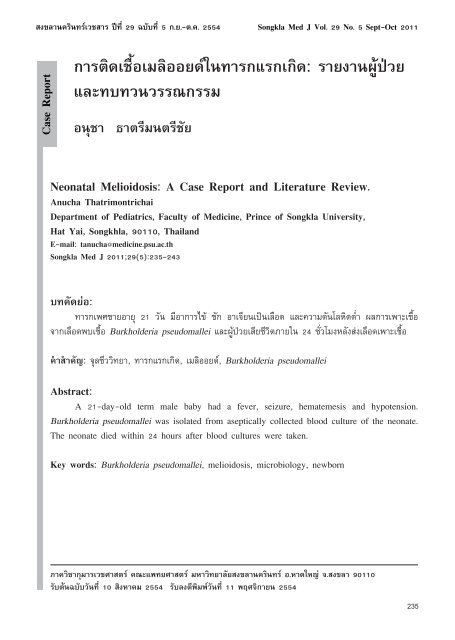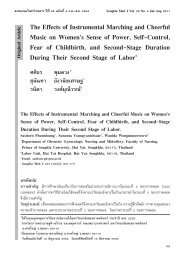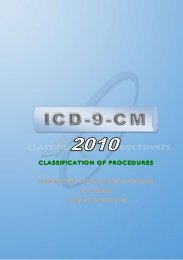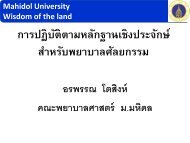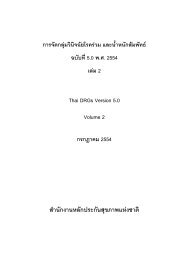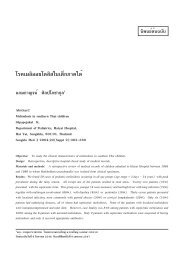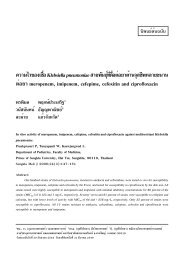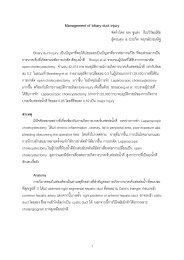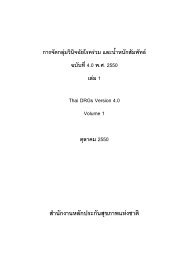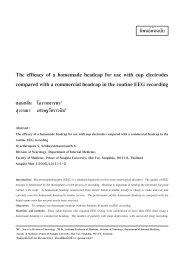A Case Report and Literature Review Anucha Thatrimontrichai ...
A Case Report and Literature Review Anucha Thatrimontrichai ...
A Case Report and Literature Review Anucha Thatrimontrichai ...
Create successful ePaper yourself
Turn your PDF publications into a flip-book with our unique Google optimized e-Paper software.
ส§¢ÅÒ¹¤ÃÔ¹·Ã์àǪสÒà »‚·Õè 29 ฉบับที่ 5 ก.ย.-ต.ค. 2554 Songkla Med J Vol. 29 No. 5 Sept-Oct 2011<br />
<strong>Case</strong> <strong>Report</strong><br />
การติดเชื้อเมลิออยด์ในทารกแรกเกิด: รายงานผู้ป่วย<br />
และทบทวนวรรณกรรม<br />
อนุชา ธาตรีมนตรีชัย<br />
Neonatal Melioidosis: A <strong>Case</strong> <strong>Report</strong> <strong>and</strong> <strong>Literature</strong> <strong>Review</strong>.<br />
<strong>Anucha</strong> <strong>Thatrimontrichai</strong><br />
Department of Pediatrics, Faculty of Medicine, Prince of Songkla University,<br />
Hat Yai, Songkhla, 90110, Thail<strong>and</strong><br />
E-mail: tanucha@medicine.psu.ac.th<br />
Songkla Med J 2011;29(5):235-243<br />
บทคัดย่อ:<br />
ทารกเพศชายอายุ 21 วัน มีอาการไข้ ชัก อาเจียนเป็นเลือด และความดันโลหิตต่ำา ผลการเพาะเชื้อ<br />
จากเลือดพบเชื้อ Burkholderia pseudomallei และผู้ป่วยเสียชีวิตภายใน 24 ชั่วโมงหลังส่งเลือดเพาะเชื้อ<br />
คำÒสำÒ¤ัญ: จุลชีววิทยา, ทารกแรกเกิด, เมลิออยด์, Burkholderia pseudomallei<br />
Abstract:<br />
A 21-day-old term male baby had a fever, seizure, hematemesis <strong>and</strong> hypotension.<br />
Burkholderia pseudomallei was isolated from aseptically collected blood culture of the neonate.<br />
The neonate died within 24 hours after blood cultures were taken.<br />
Key words: Burkholderia pseudomallei, melioidosis, microbiology, newborn<br />
ภาควิชากุมารเวชศาสตร์ คณะแพทยศาสตร์ มหาวิทยาลัยสงขลานครินทร์ อ.หาดใหญ่ จ.สงขลา 90110<br />
รับต้นฉบับวันที่ 10 สิงหาคม 2554 รับลงตีพิมพ์วันที่ 11 พฤศจิกายน 2554<br />
235
เชื้อเมลิออยด์ในทารกแรกเกิด อนุชา ธาตรีมนตรีชัย<br />
Introduction<br />
Melioidosis is a tropical infectious disease<br />
caused by a Gram-negative, motile, aerobic<br />
bacillus with bipolar staining. It is vacuolated<br />
<strong>and</strong> slender <strong>and</strong> has rounded ends; it is often<br />
described as having a “safety pin” appearance,<br />
Burkholderia pseudomallei. It is endemic to Southeast<br />
Asia <strong>and</strong> northern Australia, <strong>and</strong> cases are<br />
increasingly being reported in countries elsewhere<br />
in Asia, the Pacific, the Americas, the Caribbean,<br />
Africa, the Middle East, <strong>and</strong> Brazil, <strong>and</strong> in travelers<br />
returning from tropical countries. 1,2 To diagnose<br />
melioidosis clinically is difficult as the symptoms<br />
<strong>and</strong> signs are non-specific. It is known as ‘the<br />
great imitator’ to many other diseases. Definite<br />
diagnosis is made when Burkholderia pseudomallei<br />
is isolated from blood, pus, urine or other<br />
sterile body fluids. Almost neonatal melioidosis<br />
is bacteremia. However, the use of cultures is<br />
time consuming, usually taking at least 48 hours<br />
to obtain the result. Many severely ill patients<br />
died before the diagnosis can be established.<br />
This article reported <strong>and</strong> reviewed neonatal<br />
melioidosis literature, caused by Burkholderia<br />
pseudomallei, from 1971 to the present, to address<br />
the mode of transmission, clinical presentation,<br />
laboratory diagnosis, treatment <strong>and</strong> outcome.<br />
<strong>Case</strong> report<br />
A term male baby, appropriate for gestational<br />
age, was born spontaneous vaginal delivery<br />
attended by an unqualified midwife. He weighed<br />
2.5 kg at birth <strong>and</strong> did not receive vitamin K. He<br />
received exclusive breast feeding. He presented<br />
with hematemesis, melena <strong>and</strong> lethargy on the<br />
21 st day of life. He developed high grade fever<br />
236<br />
<strong>and</strong> seizure on right extremities <strong>and</strong> was brought<br />
to the hospital. On examination he was drowsy<br />
<strong>and</strong> had tense anterior fontanel. The pupils were<br />
3 mm in diameter both sides <strong>and</strong> react to light.<br />
There was no sign of menigism. His completed<br />
blood count revealed hematocrit 31%, white blood<br />
cell 8,700 cells/mm 3 <strong>and</strong> platelet 257,000 cells/<br />
mm 3 . The coagulogram was not performed. The<br />
serum electrolyte revealed hyponatremia with<br />
sodium of 118 mEq/l <strong>and</strong> within normal limit of<br />
other electrolyte <strong>and</strong> glucose level. The lumbar<br />
puncture found bloody cerebrospinal fluid without<br />
clotting. The child was provisionally diagnosed<br />
as gastrointestinal <strong>and</strong> intraventricular hemorrhage<br />
from acquired prothrombin complex deficiency<br />
(APCD). He received vitamin K injection, fresh<br />
frozen plasma 10 ml/kg <strong>and</strong> packed red cell<br />
10 ml/kg transfusion, cefotaxime 200 mg/kg/<br />
day, cloxacillin 200 mg/kg/day, phenobarbital<br />
10 mg/kg/day, <strong>and</strong> intravenous fluid to correct<br />
hyponatremia. Ten hour later, he developed apnea<br />
<strong>and</strong> fixed unequal pupils, 1 <strong>and</strong> 3 mm on right <strong>and</strong><br />
left side, respectively. He was intubated <strong>and</strong> put<br />
on dexamethasone. He was then referred to<br />
our hospital on the 23 rd day of life.<br />
The septic workups on arrival revealed<br />
hematocrit 28%, white blood cell 8,000 (b<strong>and</strong><br />
12%), platelet 308,000. The coagulogram was<br />
within normal limit. The emergency computed<br />
tomography (CT) scan of the brain revealed intracerebral<br />
hemorrhage at left temporal area <strong>and</strong><br />
left subdural hemorrhage with shifted midline.<br />
The craniotomy was performed for clot removal<br />
immediately. He was put on 200 mg/kg/day of<br />
cloxacillin injection. The initial blood culture<br />
obtained on the 23 rd day of life revealed methi-<br />
ส§¢ÅÒ¹¤ÃÔ¹·ร์àǪสÒà »‚·Õè 29 ©ºÑº·Õè 5 ก.ย.-ต.ค. 2554
Neonatal Melioidosis <strong>Thatrimontrichai</strong> A.<br />
cillin-susceptible Staphylococcus aureus. Two days<br />
later, he developed hypotension <strong>and</strong> deterioration<br />
of conciousness with a Glasgow Coma Scale<br />
score decrease from 6T to 2T. The repeated CT<br />
scan of the brain revealed cerebral infarction<br />
in the area supplied by middle cerebral artery<br />
<strong>and</strong> brain edema. He died after the 4 th day of<br />
admission or 26 th day of life. The hemoculture<br />
on the 25 th day of life grew Burkholderia pseudomallei<br />
susceptible to augmentin, cefotaxime,<br />
ceftazidime, chloramphenicol, imipenem, tetracycline<br />
<strong>and</strong> sulperazon, but resistant to amikacin,<br />
ampicillin, cotrimoxazole <strong>and</strong> gentamicin. The<br />
source of infection was not found.<br />
Discussion<br />
There were a total of 22 cases reported<br />
of neonatal melioidosis identified in the original<br />
search but the detailed clinical data were available<br />
in only 14 cases. The earliest case was reported<br />
in 1971, <strong>and</strong> the lastest case reported in 2011.<br />
Table 1 summarizes the main features of the 22<br />
reported cases.<br />
In Pahang state of Malaysia, the average<br />
annual incidence rate of melioidosis in children<br />
was found to be 1.6 cases per 100,000 populations.<br />
3 The incidence of neonatal melioidosis<br />
was more predominate in male than in female,<br />
similar to pediatric melioidosis. 4,5 The presence of<br />
specific risk factors for B. pseudomallei infection<br />
may be operating by impairing neutrophil<br />
function, defined virulence factors (including<br />
a type III secretion system) 1 <strong>and</strong> produces a<br />
glycocalyx polysaccharide capsule (biofilm or<br />
slime) that is probably an important virulence<br />
determinant. 6 In adults the most common clinical<br />
manifestation are rapidly progressive pneumonia<br />
<strong>and</strong> septicemia. 7 In children, on the other h<strong>and</strong>,<br />
parotitis <strong>and</strong> infections of the skin <strong>and</strong> lymph node<br />
were more common. 8 In this case, we speculated<br />
that the late-onset B. pseudomallei infection might<br />
have acquired from environmental source either<br />
by inhalation or by direct or indirect contact.<br />
Neurological melioidosis appeared to be<br />
more significant in children (3/8, 37.5%) compared<br />
to adults (6/145, 4.1%). 9 Two cases of neonatal<br />
melioidosis reported had intracranial hemorrhage<br />
diagnosed by autopsy. 10 Our case had intracranial<br />
hemorrhage caused by acquired prothrombin<br />
complex deficiency, diagnosed by no history of<br />
vitamin K injection prophylaxis <strong>and</strong> exclusive<br />
breast feeding, but not clear that intracranial<br />
hemorrhage in this case is related to melioidosis.<br />
In literature review (Table 1), all cases<br />
in neonatal period presented with bacteremia<br />
<strong>and</strong>/or meningitis. The clinical presentations of<br />
neonatal melioidosis were nonspecifically neonatal<br />
sepsis. The common signs <strong>and</strong> symptoms were<br />
fever (15/22, 68.2%), <strong>and</strong> respiratory distress<br />
(tachypnea, grunting, apnea <strong>and</strong> respiratory<br />
failure, 10/14, 71%). Of the 22 reported cases,<br />
10 reported the mode of transmission. Two<br />
cases were investigated <strong>and</strong> identified mother to<br />
child transmission, one case was from vertical<br />
transmission (placental microabscess, case 10)<br />
<strong>and</strong> the other case was from breastfeeding<br />
(case 11). The other eight cases were probably<br />
health care-associated infection <strong>and</strong> probably<br />
community acquired infection equally. Mortality<br />
rate of neonatal melioidosis was extremely high<br />
(16/22, 72.7%), 10-12 whereas death in pediatric<br />
melioidosis had only 0.37-37.5%. 9,13 Mortality in<br />
Songkla Med J Vol. 29 No. 5 Sept-Oct 2011 237
เชื้อเมลิออยด์ในทารกแรกเกิด อนุชา ธาตรีมนตรีชัย<br />
Table 1 Demographic <strong>and</strong> clinical characteristics of 22 documented cases of neonatal melioidosis sorted by year of publication<br />
<strong>Case</strong><br />
Country,<br />
year<br />
Age<br />
at<br />
onset<br />
(days)<br />
PROM<br />
Mode of<br />
delivery<br />
GA<br />
(weeks)<br />
BW<br />
(g)<br />
Mode<br />
of<br />
transmission<br />
Clinical<br />
features<br />
NA,<br />
but<br />
chrioamnionitis<br />
Investigation<br />
Diagnosis<br />
Treatment <strong>and</strong><br />
duration of<br />
antibiotics<br />
therapy<br />
Outcome<br />
1<br />
2<br />
3<br />
4<br />
5<br />
Sex<br />
USA, M<br />
1971 16<br />
Thail<strong>and</strong>, M<br />
1988 10<br />
Thail<strong>and</strong>, F<br />
1988 10<br />
Thail<strong>and</strong>, F<br />
1988 10<br />
Thail<strong>and</strong>, M<br />
1988 10<br />
2<br />
(37 h)<br />
14<br />
14<br />
IAB<br />
IAB<br />
No<br />
No<br />
No<br />
Yes<br />
(1 week)<br />
Forceps<br />
extraction<br />
Forceps<br />
extraction<br />
C/S<br />
due to<br />
placental<br />
previa<br />
totalis<br />
SVD<br />
(criminal<br />
abortion<br />
5 days<br />
before<br />
delivery)<br />
SVD<br />
Term<br />
33<br />
32<br />
32<br />
Preterm<br />
2,977<br />
1,230<br />
1,370<br />
1,340<br />
1,330<br />
NA †<br />
Probably<br />
HCAI<br />
Probably<br />
HCAI<br />
NA<br />
NA<br />
Poor<br />
sucking,<br />
lethargy,<br />
fever,<br />
jaundice,<br />
grunting<br />
Asymptomatic<br />
Respiratory<br />
distress,<br />
apnea,<br />
lethargy<br />
Asymptomatic<br />
Severe<br />
respiratory<br />
distress<br />
NA<br />
WBC6,750<br />
(PMN40%,<br />
B<strong>and</strong>11%)<br />
WBC1,980<br />
(PMN70%,<br />
B<strong>and</strong>17%)<br />
NA<br />
NA<br />
-B. pseudomallei<br />
sepsis <strong>and</strong><br />
meningitis<br />
-Depressed right<br />
frontal skull<br />
fracture<br />
-Pneumonia<br />
-B. pseudomallei<br />
<strong>and</strong> Klebsiella<br />
sepsis<br />
-Twin B, sterile<br />
CSF<br />
-B. pseudomallei<br />
sepsis, sterile CSF<br />
- Omphalitis<br />
-B. pseudomallei<br />
sepsis<br />
-B. pseudomallei<br />
sepsis<br />
-Respiratory<br />
distress syndrome<br />
-Surgery at 3 h<br />
after birth<br />
-Polymyxin B<br />
(parenterally<br />
<strong>and</strong> intrathecally),<br />
9 h<br />
-Cefotaxime<br />
<strong>and</strong> gentamicin,<br />
14 d<br />
-Ceftazidime,<br />
20 d<br />
-Penicillin <strong>and</strong><br />
gentamicin,<br />
10 d<br />
-Penicillin <strong>and</strong><br />
gentamicin,<br />
20 h<br />
Died<br />
(119 h<br />
after<br />
birth)<br />
Recovered<br />
Recovered<br />
Recovered<br />
Died (20<br />
h after<br />
birth)<br />
238<br />
ส§¢ÅÒ¹¤ÃÔ¹·ร์àǪสÒà »‚·Õè 29 ©ºÑº·Õè 5 ก.ย.-ต.ค. 2554
Neonatal Melioidosis <strong>Thatrimontrichai</strong> A.<br />
Table 1 (Continued)<br />
<strong>Case</strong><br />
Country,<br />
year<br />
6 Thail<strong>and</strong>, M<br />
1988 10<br />
7<br />
Malaysia,<br />
1993 17<br />
M<br />
8<br />
Sex<br />
Malaysia, M<br />
1998 18<br />
2001 19<br />
9<br />
Malaysia,<br />
1998 18<br />
M<br />
10<br />
Netherl<strong>and</strong>s,<br />
F<br />
Age<br />
at<br />
onset<br />
(days)<br />
5<br />
2<br />
(30 h)<br />
10<br />
8<br />
2<br />
PROM<br />
Yes (1<br />
week)<br />
NA<br />
No<br />
No<br />
NA<br />
Mode of<br />
delivery<br />
SVD, birth<br />
in a car<br />
SVD<br />
SVD, birth<br />
in an<br />
ambulance<br />
SVD<br />
C/S due<br />
to severe<br />
vaginal<br />
bleeding<br />
GA<br />
(weeks)<br />
Preterm<br />
Term<br />
Term<br />
Term<br />
32<br />
BW<br />
(g)<br />
1,600<br />
3,400<br />
3,200<br />
3,600<br />
1,850<br />
Mode<br />
of<br />
transmission<br />
Probably<br />
HCAI<br />
Probably<br />
HCAI<br />
Probably<br />
communityacquired<br />
Probably<br />
communityacquired<br />
Transmitted<br />
from<br />
mother-tochild<br />
(probably<br />
placental<br />
features<br />
Apnea<br />
Respiratory<br />
distress,<br />
lethargy,<br />
poor feeding<br />
<strong>and</strong> diffuse<br />
macular rash<br />
Clinical<br />
Respiratory<br />
distress,<br />
fever, cough,<br />
lethargy, poor<br />
feeding<br />
Fever,<br />
irritability,<br />
tachypnea,<br />
convulsion<br />
infection) ‡<br />
Respiratory<br />
distress, sepsis<br />
Investigation<br />
NA<br />
WBC6,300<br />
(PMN47%,<br />
B<strong>and</strong>7%)<br />
WBC1,400<br />
Plt.124,000<br />
(CRP>9.6<br />
mg/dl)<br />
WBC<br />
32,800<br />
(PMN83%)<br />
Plt.336,000<br />
(CRP>9.6<br />
mg/dl)<br />
NA<br />
Diagnosis<br />
-B. pseudomallei<br />
meningitis <strong>and</strong><br />
C<strong>and</strong>ida albicans<br />
sepsis<br />
-Pneumonia<br />
-B. pseudomallei<br />
<strong>and</strong> Acinetobacter<br />
sepsis<br />
-Septic shock <strong>and</strong><br />
respiratory failure<br />
from bronchopneumonia<br />
-B. pseudomallei<br />
sepsis<br />
-Septic shock,<br />
bronchopneumonia<br />
-B.pseudomallei<br />
sepsis <strong>and</strong><br />
meningitis<br />
-Pneumonia <strong>and</strong><br />
omphalitis<br />
-B. pseudomallei<br />
sepsis <strong>and</strong><br />
pneumonia<br />
-Right lung abscess<br />
-Placental<br />
microabscesses<br />
Treatment <strong>and</strong><br />
duration of<br />
antibiotics<br />
therapy<br />
-Cefotaxime,<br />
4 h<br />
-Penicillin <strong>and</strong><br />
gentamicin, 1 d<br />
then<br />
-Ticarcillin, 2 d<br />
-Cloxacillin <strong>and</strong><br />
gentamicin<br />
-Cefotaxime <strong>and</strong><br />
gentamicillin,<br />
then<br />
-Ceftazidime,<br />
3 weeks<br />
-Ceftazidime,<br />
8 weeks then<br />
-Amoxicillinclavulanate,<br />
6 weeks<br />
Outcome<br />
Died (9 th<br />
date of<br />
life)<br />
Died (5 th<br />
date of<br />
life)<br />
Died (20 h<br />
after<br />
admission)<br />
Recovered<br />
Recovered<br />
Songkla Med J Vol. 29 No. 5 Sept-Oct 2011 239
เชื้อเมลิออยด์ในทารกแรกเกิด อนุชา ธาตรีมนตรีชัย<br />
Table 1 (Continued)<br />
<strong>Case</strong><br />
Country,<br />
year<br />
11 Australia, M<br />
2004 20<br />
12-19 Thail<strong>and</strong>,<br />
2004 12<br />
NA<br />
20<br />
Malaysia,<br />
2005 21<br />
F<br />
21<br />
Sex<br />
India, F<br />
2009 11<br />
Age<br />
at<br />
onset<br />
(days)<br />
2<br />
NA<br />
8<br />
IAB<br />
PROM<br />
NA<br />
(mastitis<br />
at 2 nd date<br />
before<br />
delivery)<br />
NA<br />
NA<br />
Yes<br />
Mode of<br />
delivery<br />
SVD<br />
NA<br />
SVD, birth<br />
at home<br />
SVD<br />
GA<br />
(weeks)<br />
37<br />
NA<br />
Term<br />
35<br />
BW<br />
(g)<br />
3,020<br />
NA<br />
2,700<br />
1,900<br />
Mode<br />
of<br />
transmission<br />
Transmitted<br />
from<br />
mother-tochild<br />
§<br />
NA<br />
Probably<br />
communityacquired<br />
NA*<br />
Clinical<br />
features<br />
Fever,<br />
tachypnea,<br />
bradycardia,<br />
hypotension<br />
Fever (100%),<br />
peritonitis<br />
(2/8)<br />
Fever,<br />
progressive<br />
abdominal<br />
distension,<br />
vomiting,<br />
lethargy, poor<br />
feeding, pale,<br />
respiratory<br />
distress,<br />
hypotension<br />
Fever,<br />
grunting,<br />
tachypnea,<br />
lethargy, poor<br />
peripheral<br />
perfusion<br />
Investigation<br />
WBC1,900<br />
Plt.18,000<br />
NA<br />
NA<br />
(normal<br />
LFT, CRP><br />
12.8 mg/<br />
dl)<br />
WBC4,500<br />
(normal<br />
LFT)<br />
Diagnosis<br />
-B. pseudomallei<br />
sepsis<br />
-Septic shock <strong>and</strong><br />
respiratory failure<br />
-B. pseudomallei<br />
sepsis<br />
-B. pseudomallei<br />
sepsis <strong>and</strong><br />
pneumonia<br />
-Acute respiratory<br />
distress syndrome<br />
-B. pseudomallei<br />
sepsis<br />
-Bronchopneumonia<br />
Treatment <strong>and</strong><br />
duration of<br />
antibiotics<br />
therapy<br />
-Ampicillin <strong>and</strong><br />
gentamicin<br />
NA<br />
-Cefotaxime (200<br />
mg/kg/day) <strong>and</strong><br />
piperacillin<br />
(200 mg/kg/<br />
day), 2 d then<br />
-Ceftazidime 50<br />
mg/kg/dose<br />
q 12 h<br />
-Ceftriaxone <strong>and</strong><br />
gentamicin,<br />
1 d then<br />
-Ceftazidime <strong>and</strong><br />
vancomycin,<br />
10 d then<br />
-Amoxicillinclavulanate,<br />
2 weeks<br />
Outcome<br />
Died (5 th<br />
date of<br />
life)<br />
All died<br />
(1 st -3 rd<br />
date after<br />
admission)<br />
Died (30 th<br />
date of<br />
life)<br />
Recovered<br />
240<br />
ส§¢ÅÒ¹¤ÃÔ¹·ร์àǪสÒà »‚·Õè 29 ©ºÑº·Õè 5 ก.ย.-ต.ค. 2554
Neonatal Melioidosis <strong>Thatrimontrichai</strong> A.<br />
Table 1 (Continued)<br />
<strong>Case</strong><br />
Country,<br />
year<br />
Sex<br />
Age<br />
at<br />
onset<br />
(days)<br />
PROM<br />
Mode of<br />
delivery<br />
GA<br />
(weeks)<br />
BW<br />
(g)<br />
Mode<br />
of<br />
transmission<br />
Clinical<br />
features<br />
Probably<br />
communityacquired<br />
Investigation<br />
Diagnosis<br />
Treatment <strong>and</strong><br />
duration of<br />
antibiotics<br />
therapy<br />
Outcome<br />
22<br />
Thail<strong>and</strong><br />
(present<br />
case)<br />
M<br />
21<br />
NA<br />
SVD, by<br />
unqualified<br />
midwife<br />
Term<br />
2,500<br />
Fever,<br />
hematemesis,<br />
melena,<br />
lethargy,<br />
seizure<br />
WBC8,700<br />
(PMN51%<br />
B<strong>and</strong>12%)<br />
Plt257,000,<br />
normal<br />
LFT<br />
-B. pseudomallei<br />
<strong>and</strong> methicillinsusceptible<br />
Staphylococcus<br />
aureus sepsis<br />
-Septic shock<br />
-Gastrointestinal<br />
<strong>and</strong> intracerebral<br />
hemorrhage<br />
from acquired<br />
prothrombin<br />
complex deficiency<br />
-Brain herniation<br />
-Cloxacillin (200<br />
mg/kg/day)<br />
Died (26 _<br />
date of<br />
life)<br />
† = Cultures of the mother’s urogenital tract were negative for B. pseudomallei. The father had recent military service in Vietnam, but he had no contact with the infant. The maternal<br />
gr<strong>and</strong>mother had diabetes mellitus.<br />
‡ = On prednisone due to ulcerative colitis <strong>and</strong> had vacation to Thail<strong>and</strong>. Cervical culture showed B. pseudomallei with both IgG <strong>and</strong> IgM enzyme immunoassay were reactive<br />
§<br />
= B. pseudomallei total antibody titer of 1/160 by indirect hemagglutination inhibition with both IgG <strong>and</strong> IgM enzyme immunoassay were reactive<br />
* = Vaginal swab of the mother or environmental samples from the NICU were not recovered B. pseudomallei.<br />
C/S = Cesarean section, CSF = cerebrospinal fluid, F = Female, HCAI = Health care-associated infection, IAB = immediately after birth, M = Male, NA = not available,<br />
PMN = polynuclear neutrophil, Plt = platelet, PROM = premature rupture of membrane, SVD = Spontaneous vaginal delivery, USA = United States of America,<br />
WBC = white blood cell<br />
Songkla Med J Vol. 29 No. 5 Sept-Oct 2011 241
เชื้อเมลิออยด์ในทารกแรกเกิด อนุชา ธาตรีมนตรีชัย<br />
pediatric melioidosis who were bacteremia was<br />
reported to be between 25-80%. 4,14,15 There was no<br />
mortality reported in localized infection 4,14 There<br />
was no report of relapsed infection in survived<br />
newborns <strong>and</strong> some patients were not elucidated.<br />
Burkholderia pseudomallei has unusual<br />
antimicrobial susceptibility patterns. It is resistant<br />
to aminoglycosides except kanamycin, <strong>and</strong> sensitive<br />
to the cefazidine, amoxycillin/clavulanate, <strong>and</strong><br />
carbapenems. There have been no guidelines of<br />
types of antibiotic <strong>and</strong> duration of therapy available<br />
for neonatal melioidosis.<br />
Conclusion<br />
Melioidosis is a rare bacterial infection in<br />
neonates <strong>and</strong> should be considered in the cases<br />
of sepsis. We hope this report alerts general<br />
pediatricians <strong>and</strong> neonatologists, especially in<br />
endemic areas, to consider melioidosis as a<br />
possible cause of sepsis in neonates.<br />
References<br />
1. Cheng AC, Currie BJ. Melioidosis: epidemiology,<br />
pathophysiology, <strong>and</strong> management. Clin<br />
Microbiol Rev 2005; 18: 383 - 416.<br />
2. Rolim DB, Vilar DC, de Goes Cavalcanti LP,<br />
et al. Burkholderia pseudomallei antibodies in<br />
individuals living in endemic regions in Northeastern<br />
Brazil. Am J Trop Med Hyg 2011; 84:<br />
302 - 5.<br />
3. How SH, Ng TH, Jamalludin AR, et al. Pahang<br />
melioidosis registry. Med J Malaysia 2009; 64: 27-<br />
30.<br />
4. How HS, Ng KH, Yeo HB, et al. Pediatric melioidosis<br />
in Pahang, Malaysia. J Microbiol Immunol<br />
Infect 2005; 38: 314 - 9.<br />
5. Suputtamongkol Y, Hall AJ, Dance DA, et al.<br />
The epidemiology of melioidosis in Ubon Ratchatani,<br />
northeast Thail<strong>and</strong>. Int J Epidemiol 1994; 23:<br />
1082 - 90.<br />
6. Steinmetz I, Rohde M, Brenneke B. Purification<br />
<strong>and</strong> characterization of an exopolysaccharide of<br />
Burkholderia (Pseudomonas) pseudomallei. Infect<br />
Immun 1995; 63: 3959 - 65.<br />
7. Chaowagul W, White NJ, Dance DA, et al. Melioidosis:<br />
a major cause of community-acquired<br />
septicemia in northeastern Thail<strong>and</strong>. J Infect<br />
Dis 1989; 159: 890 - 9.<br />
8. Dance DA, Davis TM, Wattanagoon Y, et al.<br />
Acute suppurative parotitis caused by Pseudomonas<br />
pseudomallei in children. J Infect Dis 1989; 159:<br />
654 - 60.<br />
9. K<strong>and</strong>asamy Y, Norton R. Paediatric melioidosis in<br />
North Queensl<strong>and</strong>, Australia. J Paediatr Child<br />
Health 2008; 44: 706 - 8.<br />
10. Lumbiganon P, Pengsaa K, Puapermpoonsiri S,<br />
et al. Neonatal melioidosis: a report of 5 cases.<br />
Pediatr Infect Dis J 1988; 7: 634 - 6.<br />
11. Noyal MJC, Harish BN, Bhat V, et al. Neonatal<br />
melioidosis: a case report from India. Indian J<br />
2009; 27: 260 - 3.<br />
12. Silpapojakul K. Melioidosis in southern Thai<br />
children. Songkla Med J 2004; 22: 363 - 9.<br />
13. Currie BJ, Ward L, Cheng AC. The epidemiology<br />
<strong>and</strong> clinical spectrum of melioidosis: 540 cases<br />
from the 20 year Darwin prospective study. PLoS<br />
Negl Trop Dis 2010; 4: e900.<br />
14. Lumbiganon P, Chotechuangnirun N, Kosalaraksa P.<br />
Clinical experience with treatment of melioidosis<br />
in children. Pediatr Infect Dis J 2004; 23: 1165 - 6.<br />
15. Pagnarith Y, Kumar V, Thaipadungpanit J, et al.<br />
Emergence of pediatric melioidosis in Siem Reap,<br />
Cambodia. Am J Trop Med Hyg 2010; 82: 1106 - 12.<br />
16. Osteraas GR, Hardman JM, Bass JW, et al.<br />
Neonatal melioidosis. Am J Dis Child 1971; 122:<br />
446 - 8.<br />
17. Halder D, Abdullah WA, Johari MR, et al. Neonatal<br />
melioidosis. Singapore Med J 1993; 34: 85 - 6.<br />
242<br />
ส§¢ÅÒ¹¤ÃÔ¹·ร์àǪสÒà »‚·Õè 29 ©ºÑº·Õè 5 ก.ย.-ต.ค. 2554
Neonatal Melioidosis <strong>Thatrimontrichai</strong> A.<br />
18. Halder D, Zainal N, Wah CM, et al. Neonatal<br />
meningitis <strong>and</strong> septicaemia caused by Burkholderia<br />
pseudomallei. Ann Trop Paediatr 1998; 18:<br />
161 - 4.<br />
19. Abbink FC, Orendi JM, de Beaufort AJ. Motherto-child<br />
transmission of Burkholderia pseudomallei.<br />
N Engl J Med 2001; 344: 1171 - 2.<br />
20. Ralph A, McBride J, Currie BJ. Transmission of<br />
Burkholderia pseudomallei via breast milk in<br />
northern Australia. Pediatr Infect Dis J 2004; 23:<br />
1169 - 71.<br />
21. Ang YM. Neonatal meliodosis: very rare but be<br />
aware. Med J Malaysia 2005; 60: 99 - 102.<br />
Songkla Med J Vol. 29 No. 5 Sept-Oct 2011 243


